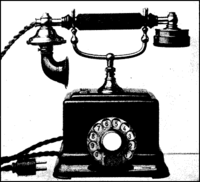Telephony
From Just Solve the File Format Problem
(Difference between revisions)
Dan Tobias (Talk | contribs) (→External links) |
Dan Tobias (Talk | contribs) (→External links) |
||
| Line 23: | Line 23: | ||
* [http://gizmodo.com/5994589/why-your-cell-phone-doesnt-have-a-dial-tone Why your cell phone doesn't have a dial tone] | * [http://gizmodo.com/5994589/why-your-cell-phone-doesnt-have-a-dial-tone Why your cell phone doesn't have a dial tone] | ||
* [http://www.avclub.com/articles/huey-lewis-and-phone-phreaking-with-phil-lapsley,97397/ Interview about phone phreaking] | * [http://www.avclub.com/articles/huey-lewis-and-phone-phreaking-with-phil-lapsley,97397/ Interview about phone phreaking] | ||
| + | * [http://www.retrothing.com/2009/05/1964-modem-reaches-out-and-touches-the-internet.html 1964 Modem Reaches Out And Touches The Internet] | ||
Revision as of 20:28, 2 June 2013
Since Alexander Graham Bell invented the telephone in 1876, it has been a major feature in our lives, evolving from wired "Plain Old Telephone Service" (POTS) to now support a whole range of mobile phone protocols and Internet-based Voice Over IP (VOIP). AT&T introduced picturephones in 1964, but they didn't catch on then; however, various forms of video chatting are now commonplace to accompany traditional voice-only telephony.
See also Address books and contacts for formats used to store contact lists on mobile phones, and Audio and Music and Video for formats used to store sounds and moving images.
